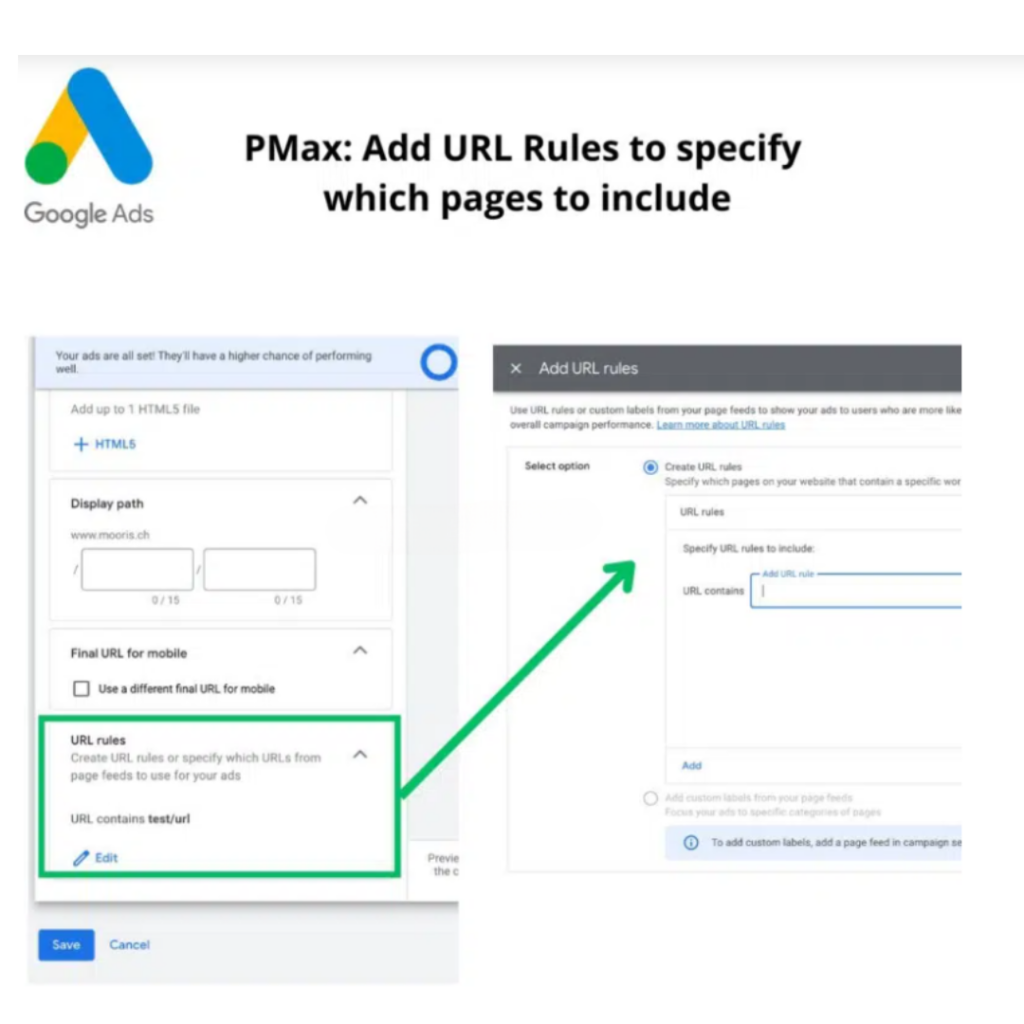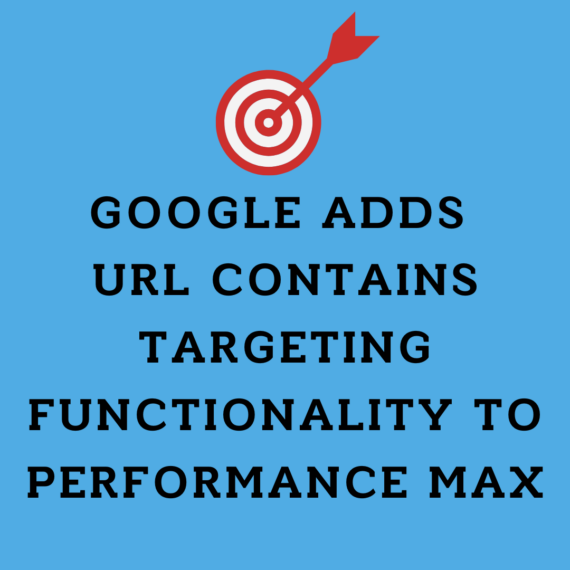How Google’s New ‘URL Contains’ Targeting in PMax Revolutionizes Digital Advertising
Right Shout
In Uncategorized Posted September 14, 2023
Google has made a significant move to enhance its Performance Max (PMax) offerings. The tech giant has recently introduced the “URL Contains” targeting feature in PMax, which previously existed in Dynamic Search Ads (DSA). The goal? To provide a more streamlined and targeted advertising experience.
What's New?
This newly introduced feature allows advertisers to manually specify the URLs they want their PMax ads to show on. For instance, if you have a PMax ad designed specifically for a product category, such as Nike shoes, you can instruct the ad to be displayed on URLs containing the token “/shoes”.
Thomas Eccel, a Google Ads expert, shed light on the importance of this feature in a statement to Search Engine Land. He said, “A PMax campaign with the Final Url expansion can virtually redirect users to any URL, such as blogs or about us pages. To prevent non-monetizable pages from being targeted, this URL rule can now instruct PMax to redirect users only to specific pages, such as those containing ‘/shop’.”

The Rationale
Why such a feature? In simple words, control. This functionality grants marketers direct control over where their ads appear, ensuring that they target more specific and relevant audiences. The core benefit lies in the precision it offers.

The Era of Personalization in Advertising
In today’s rapidly evolving digital landscape, consumers are inundated with countless ads every day. From the moment they unlock their smartphones in the morning to their last-minute night-time browsing, ads are omnipresent. This constant barrage shopping ads has made generic, one-size-fits-all advertisements less impactful. Consumers now expect ads that resonate with their unique needs and preferences. In essence, they desire personalization.
Understanding the Demand for Precision
To understand why Google’s ‘URL Contains’ feature is so significant, we need to first recognize the importance of precision in modern advertising. As markets become more saturated and consumers more discerning, the margin for error in advertising shrinks. Gone are the days when a broad-strokes campaign could achieve wide-scale success. Today’s consumers are tech-savvy and have become adept at filtering out irrelevant content. They demand relevance, and they want it consistently.
Empowering Advertisers with Granular Control
With the ‘URL Contains’ functionality, Google has provided advertisers a tool to finetune their ad placements. Imagine being able to ensure that your gourmet coffee ad appears only on blogs discussing artisanal coffee techniques, or that every ad spend every single campaign for your high-end athletic wear is advertised on pages focusing on professional training routines. This level of granular control ensures not only that ads reach the right eyes but also that they resonate, leading to higher engagement and conversion rates.
Precision: A Double-Edged Sword
While the precision the ‘URL Contains’ feature offers search campaigns and ad groups is undeniably powerful, it also demands a higher level of strategy from advertisers. It’s not just about targeting the ad group the right URLs, but understanding the nuances of consumer behavior, predicting their online pathways, and placing ads at the right digital touchpoints. This strategic depth means advertisers need to be more attuned to their audience’s desires and online behaviors than ever before.
The ‘URL Contains’ feature is more than just another tool in the digital advertiser’s kit—it’s a reflection of the changing tides in consumer expectations and the increasing importance of personalized, relevant content. In the hands of a skilled marketer, it promises not just control, but a chance to genuinely connect with audiences in a crowded digital space.
The Nitty-Gritty
The function works by targeting pages whose URLs contain specific text segments or “tokens”. A token is essentially a text segment set apart by limiters such as “/”, “-“, and more. It’s worth noting that URLs like “electronicsexample.com/servicesmenu/” wouldn’t be targeted because “menu” follows the keyword “services” without a limiter. Conversely, “electronicsexample.com/services-menu/” would be targeted since “services” is distinct from “menu” thanks to the “-“.

Other URL separators that can be used with this feature include:
“:”
“/”
“?”
“+”
“&”
Real-world Applications: How Marketers Use Tokens for Precision
Consider an e-commerce website. It may have various sections: men’s apparel, women’s apparel, accessories, shoes, etc. By utilizing the ‘URL Contains’ feature, an advertiser selling women’s shoes could specifically target potential customers with URLs containing the token “/women-shoes” or “/female-footwear”, ensuring their ad is displayed to a highly relevant audience.
Words from Google
“Highlighting the goal behind this move, a representative from Google mentioned to Search Engine Land, “We’ve introduced the URL Contains targeting functionality to Performance Max to support DSA use cases in PMax better. This is part of the voluntary upgrade we announced in July. The feature operates in PMax just as it does in DSA today.”

1. The Evolution of Targeted Advertising
A look back at how targeted advertising has evolved over the years, tracing back to the early days of simple keyword matching to the present where URL segment targeting can refine audience reach and serve ads maximize conversions.
2. Breaking Down the 'URL Contains' Feature
A detailed explanation of what the ‘URL Contains’ targeting feature is, how it works, and why it’s different from other targeting methods available.
3. The Power of Precision: Why 'URL Contains' Matters
Exploring the benefits of using this new feature, including increased conversion value, ad relevance, more conversion goals better ROI ad campaigns, and improved user experience.
4. Practical Applications and Use Cases
Real-world examples of how businesses can leverage ‘URL Contains’ for better ad placements. For instance, how a shoe company can ensure its ads are shown more relevant to landing page content or on URLs specific to shoe enthusiasts or shopping pages.
5. Potential Pitfalls and How to Avoid Them
A guide on common mistakes advertisers might make with this new feature and tips on how to prevent them.
6. Comparing PMax's 'URL Contains' with Dynamic Search Ads (DSA)
A side-by-side comparison of campaign performance of PMax and DSA in the context of the ‘URL Contains’ feature, helping advertisers decide the best platform for the campaign type their needs.
7. Future Predictions: Where is Digital Advertising Headed?
A speculative section on the potential advancements and changes we might see in the world of digital advertising, given the constant innovations from giants branded search, like Google.
Conclusion
The integration of the “URL Contains” targeting functionality into PMax from DSA signifies Google’s commitment to refining and enhancing the advertiser experience. By allowing brands and marketers to have a more focused approach in their ad placements, Google ensures that the right audience sees the right ads, enhancing both the user and advertiser experience.
FAQs
1. What is the "URL Contains" targeting feature in PMax?
It’s a new feature that allows performance max advertisers to specify the URLs on which they want their PMax ads to appear by targeting specific tokens or segments of text within the URL.
2. Is this feature unique to Performance Max ads?
No, this feature was previously available in Dynamic Search Ads (DSA) and has now been introduced to Performance Max.
3. Why was this feature added to PMax?
Google added this functionality to better support Dynamic Search Ads use cases within PMax, offering advertisers more control and precision over where their ads appear.
4. How does the "URL Contains" targeting function work?
Advertisers can target pages with URLs that contain specific text segments or “tokens”, which are pieces of text separated by limiters such as “/”, “-“, etc.
5. Can I target any URL with this feature?
No, the targeted token in the URL should be separated from other words by limiters. For instance, “electronicsexample.com/servicesmenu/” wouldn’t be targeted, but “electronicsexample.com/services-menu/” would be.
6. What are the typical separators or limiters recognized by this feature?
Some common URL separators include “:”, “/”, “?”, “+”, and “&”.
7. Why is this new functionality useful for advertisers?
It provides advertisers with greater control over their ad placements, ensuring ads are
displayed to a more specific and relevant audience, thereby improving ad effectiveness.
8. What has Google officially said about this new feature?
Google has confirmed the rollout of this feature for PMax, noting its similarity with the existing DSA functionality and emphasizing its utility in supporting DSA use cases within PMax.
9. Can I use this feature to exclude specific pages from my ad placements?
Yes, by specifying which URLs or tokens you want your ads to target, you can effectively exclude non-relevant or non-monetizable pages.
10. Who can benefit the most from this feature?
Marketers and advertisers looking for precise control over campaign performance of their ad placements on Google will find this feature especially beneficial, ensuring that their ads are viewed by the most relevant audience.





